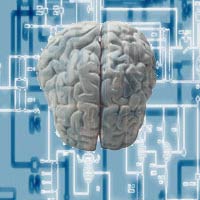Posted 19 July 2004 - 10:19 AM
The June issue of Journals of Gerontology Series A: Biological Sciences and Medical Sciences finally came online today (about bloody time, as they say down under). After scanning all the articles here's a sampling:
1. Hayflick's ongoing pathological assertion that aging is caused only by molecular entropy and is a condition for which never will an intervention be found is counterbalanced by his observation that only microscopic amounts of resources are made available for research in this area. One at times feels that he is provoking the scientific community to get off their collective arse and prove him wrong.
I almost chocked on my omelet on this one and had to clean up my keyboard - it relates to Hayflick's molecular entropy theory and how genes are irrelevant to aging:
Just as a blueprint is vital to manufacture a complex machine and contains no information to cause the aging of that machine, the genome is necessary to govern biological development and maintenance but unnecessary to cause the animal's aging. The animal and the machine ultimately fail because of thermodynamically driven losses in molecular fidelity. In living systems, this continued loss of fidelity eventually exceeds repair capacity and leads to increased vulnerability to predation, accidents, or pathology. In inanimate objects, similar molecular changes also will exceed repair capacity and increase vulnerability to analogous irreversible failure in some vital component.
Because genes do not drive the aging process, an understanding of the human genome, even beyond what is known today, will not provide insights into a process that is random and thermodynamically driven.
But wait, there's more:
The belief, even among some gerontologists, that we are on the verge of intervening in the aging process in humans has become so widespread recently that several calls have been made to debate the value of doing so. They admonish us to engage in dialogues on the serious impact that having the ability to perturb the aging process in humans would bring to virtually all of our institutions.
Funnily enough there are a few of these "why should we live longer" types of articles in this issue. Of course he summarily trashes them. But does the usual bit of a "teaze" with how little research is being conducted.
It is doubtful that a public dialogue on this issue will ever be needed for several reasons, the least of which is that very little research is conducted on efforts to understand the biology of aging and even less is directed toward intervening in the process. Second, we cannot even slow, stop, or reverse the aging process in such far simpler entities than ourselves as are, for example, our own automobiles. Some have argued that this analogy is flawed because inanimate objects do not have the capability for repair, as do humans. However, our repair processes also age, and despite the existence of an enormous automobile repair industry, no one has yet solved the aging problem in cars or in the repair shops themselves, who like all else in the universe, suffer the same fate. As stated earlier, because the aging process is a universal property of all molecules (and most atoms), intervention in the aging process borders on the likelihood of violating fundamental laws of physics.
2. Holliday, with whom Hayflick debates also is convinced that an intervention for aging is virtually impossible despite the fact that he breaks down the cause of aging into numerous categories (the solution to some of these is where Aubrey de Grey's SENS is derived from). Like Hayflick, Holliday also agrees on the miniscule resources devoted to investigating the causes of aging.
Thankfully Holliday acknowledges the genetic contribution to aging:
The true number of genes involved in the determination of longevity is likely to be very large. Each maintenance mechanism depends on a large number of genes, for example, DNA repair has multiple pathways and each pathway depends on several enzymes. It is also now known that there are close interrelationships between DNA repair and the cell cycle. It would be damaging for a cell with unrepaired DNA lesions to attempt to divide, so such division only occurs when DNA repair is complete, apart from the special case of error-prone repair. There are many genes involved in other maintenance mechanisms, such as proteolysis, defense against ROS, the immune system, detoxification, and so forth. The conclusion must be that a very large number of genes control or determine, in one way or another, the efficiency of cell and tissue maintenance. All these genes contribute, to a greater or lesser extent, to the maximum longevity of the organism in a favorable environment. The very existence of multiple maintenance mechanisms also means that they act as different defenses against the multiple causes of aging.
3. The war on the fraudulent nature of the anti-aging industry is covered, which is something that is very important. There's a lot of misinformation out there by quasi-scientist or unethical scientist types who seek to validate the latest supplement or treatment by citing what appears to be relevant legitimate research. Of course the majority of people will have trouble getting past the heading from a pubmed article let alone be in the position to evaluate its relevance to the product advertised. It is becoming a lucrative industry:
A research report prepared by a "knowledge services company," FIND/SVP, estimates that the anti-aging market was about $43 billion in 2002 and could increase to $64 billion by 2007. However, it defines the market very broadly in terms of five categories: cosmetic treatments and surgery; exercise and therapy; food and beverages; vitamins, minerals, and supplements; and cosmetics and cosmeceuticals.
In my view none of the above categories constitute scientific and legitimate anti-aging which can only be brought about by changes in gene function. In this regard, I can sympathize with the vitriolic approach of some senior researchers towards the "anti-aging" movement.
I found this reference to Hayflick intriguing:
Even biogerontologist Leonard Hayflick-regarded by many in the field as having laid the groundwork for contemporary research advances in molecular mechanisms of aging - has long feared the societal implications of slowing or arresting the aging process such as worldwide overpopulation and its consequences. However, he joins with most other biogerontologists and gerontologists in regarding as highly desirable the compression of morbidity as long as it does not involve extending average life expectancy beyond 100 years.
Why are all these biogerontologists so scared of getting people to live longer if they think its so impossible?













































